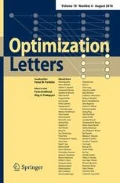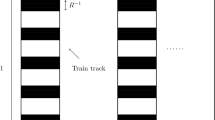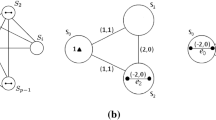Abstract
In this paper, we consider a problem of optimal covering a barrier in the form of a line segment with equal circles distributed in a plane by moving their centers onto the segment or the line containing a segment. We require the neighboring circles in the cover to touch each other. The objective is to minimize the total traveled by circles Euclidian distance. The complexity status of the problem is not known. We propose an \(O(\frac{t_{AP}(n)}{\varepsilon ^2})\)–time FPTAS for the problem, where n is the number of circles and \(t_{AP}(n)\) is the time complexity of solving an assignment problem which is at most \(O(n^3)\).


Similar content being viewed by others
References
Agarwal, P.K., Efrat, A., Sharir, M.: Vertical decomposition of shallow levels in 3-dimensional arrangements and its applications. SIAM J. Comput. 29(3), 912–953 (2006)
Andrews, A.M., Wang, H.: Minimizing the aggregate movements for interval coverage. Algorithmica 78(1), 47–85 (2017)
Bar-Noy, A., Rawitz, D., Terlecky, P.: “Green” barrier coverage with mobile sensors. In: Algorithms and Complexity: Proceedings of the 9th International Conference, CIAC 2015, Paris, France, pp. 33–46. Springer (2015)
Benkoczi, R., Friggstad, Z., Gaur, D., Thom, M.: Minimizing total sensor movement for barrier coverage by non-uniform sensors on a line. In: Proc. of the 11th International Symposium on Algorithms and Experiments for Wireless Sensor Networks, vol. 9536, pp. 98–111. LNCS (2015)
Bhattacharya, B.K., Burmester, M., Hu, Y., Kranakis, E., Shi, Q., Wiese, A.: Optimal movement of mobile sensors for barrier coverage of a planar region. Theor. Comput. Sci. 410(52), 5515–5528 (2008)
Carmi, P., Katz, M.J., Saban, R., Stein, Y.: Improved PTASs for convex barrier coverage. In: Solis-Oba, R., Fleischer, R. (eds.) Approximation and Online Algorithms, WAOA 2017, LNCS, vol. 10787, pp. 26–40. Springer, Cham (2017)
Chen, A., Kumar, S., Lai, T.H.: Designing localized algorithms for barrier coverage. In: Proceedings of the 13th Annual ACM International Conference on Mobile Computing and Networking, pp. 63–74 (2007)
Chen, A., Lai, T.H., Xuan, D.: Measuring and guaranteeing quality of barrier-coverage in wireless sensor networks. In: Proceedings of the ACM International Symposium on Mobile Ad Hoc Networking and Computing (MobiHoc), pp. 421–430 (2008)
Cherry, A., Gudmundsson, J., Mestre, J.: Barrier coverage with uniform radii in 2D. In: Fernandez, Anta A., et al. (eds.) ALGOSENSORS 2017, LNCS, vol. 10718, pp. 57–69. Springer, Cham (2017)
Czyzowicz, J., et al.: On minimizing the sum of sensor movements for barrier coverage of a line segment. In: Nikolaidis, I., Wu, K. (eds.) Ad-Hoc, Mobile and Wireless Networks, LNSC, vol. 6288, pp. 29–42. Springer, Berlin, Heidelberg (2010)
Erzin, A., Lagutkina, N.: Barrier coverage problem in 2D. In: Gilbert, S., et al. (eds.) ALGOSENSORS 2018, LNCS, vol. 11410, pp. 118–130. Springer, Berlin, Heidelberg (2019)
Erzin, A., Lagutkina, N., Ioramishvili, N.: Barrier covering in 2D using mobile sensors with circular coverage areas. In: Matsatsinis, N.F., et al. (eds.) LION 2019, LNCS, vol. 11968, pp. 342–354. Springer, Cham (2020)
Fan, H., Li, M., Sun, X., Wan, P., Zhao, Y.: Barrier coverage by sensors with adjustable ranges. ACM Trans. Sens. Netw. 11(1), 14 (2014)
Kuhn, H.: The Hungarian method for the assignment problem. Naval Res. Logist. Q. 2, 83–97 (1955)
Lawler, E.: Combinatorial Optimization: Networks and Matroids. Saunders College Publishing, Fort Worth (1976)
Saipulla, A., Westphal, C., Liu, B., Wang, J.: Barrier coverage with line-based deployed mobile sensors. Ad Hoc Netw. 11(4), 1381–1391 (2010)
Thom, M.: Investigation on two classes of covering problems. Ph.D. thesis, University of Lethbridge, Canada (2017)
Vaidya, P.: Geometry helps in matching. SIAM J. Comput. 18, 1201–1225 (1989)
Wu, F., Gui, Y., Wang, Z., Gao, X., Chen, G.: A survey on barrier coverage with sensors. Front. Comput. Sci. 10(6), 968–984 (2016)
Zhang, X.: Algorithms for barrier coverage with wireless sensors. Ph.D. thesis, City University of Hong Kong, Hong Kong (2016)
Zhao, L., Bai, G., Shen, H., Tang, Z.: Strong barrier coverage of directional sensor networks with mobile sensors. Int. J. Distrib. Sens. Netw. 14(2) (2018). https://doi.org/10.1177/1550147718761582
Author information
Authors and Affiliations
Corresponding author
Additional information
Publisher's Note
Springer Nature remains neutral with regard to jurisdictional claims in published maps and institutional affiliations.
Rights and permissions
About this article
Cite this article
Erzin, A., Lagutkina, N. FPTAS for barrier covering problem with equal touching circles in 2D. Optim Lett 15, 1397–1406 (2021). https://doi.org/10.1007/s11590-020-01650-8
Received:
Accepted:
Published:
Issue Date:
DOI: https://doi.org/10.1007/s11590-020-01650-8




